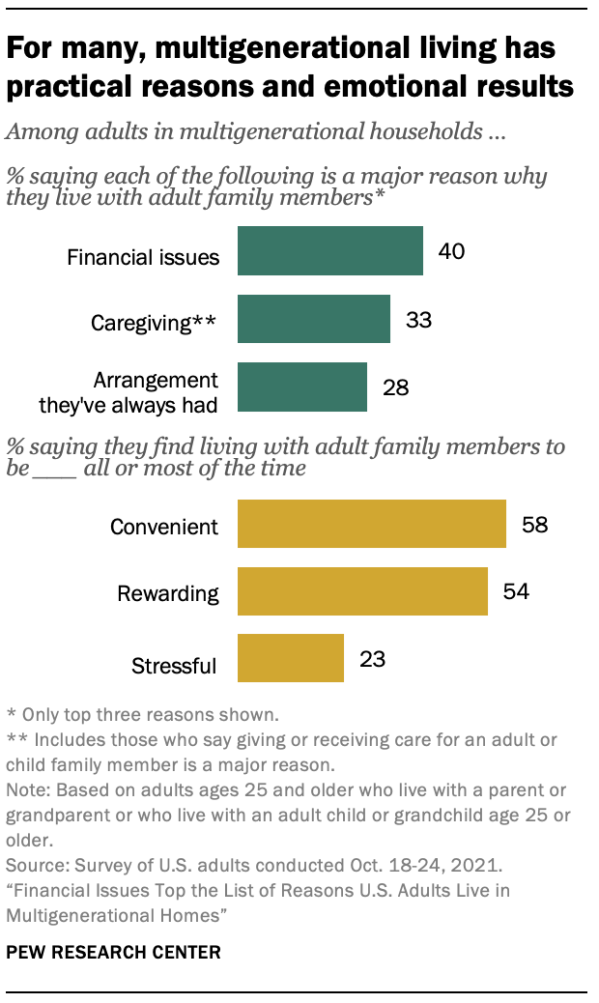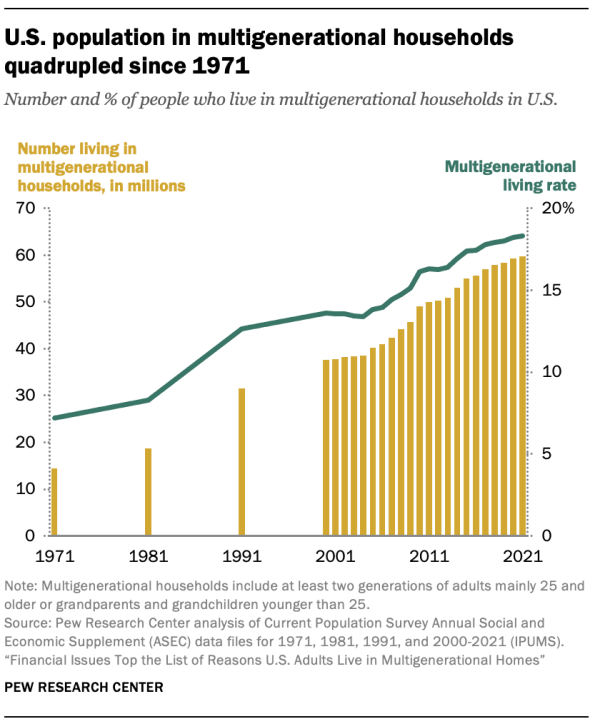Are you looking for a new home for your growing family plus members of your extended family? Do you want to keep close ties to the generations before and after you? Do you want to pool resources to get a bigger, better home?
Look no further than multigenerational housing! This type of living arrangement, where two or more generations live in a single structure or on the same property, has recently been gaining in popularity in the US and beyond. With many benefits from more efficient use of space, reduced financial burdens, improved emotional well-being, and more, it’s easy to see why so many people are reconsidering these types of homes. Let’s take a look at what makes multigenerational housing an option for many families!

What Is Multigenerational Housing?
While it’s nothing new, most families in the US opt for single-family living with parents and their children being the primary residents. The typical single-family home may have space for the occasional guest (which usually also serves some other purpose such as storage or crafting).
Multigenerational housing is the growing trend of extended families living together in a single household. This beneficial dynamic offers more support for both younger and older family members. It also helps foster relationships that would otherwise be lost with different generations living apart. From accommodating larger families to providing an economical way to save on rent or mortgage, multigenerational living has plenty of perks – and it’s ushering in a new era of inventive living solutions.
The number of Americans living in a multigenerational household with three or more generations has nearly quadrupled over the past decade, with a dramatic increase of 271 percent from 2011 to 2021.
Generations United
While the trend has been growing, it’s certainly not a new idea for humans. Throughout history, it has made more sense for families to pool resources and live under the same roof or on the same property.
Even in more recent human history when most people buy a single-family home, there has been a need for homes with an in-law suite to accommodate an aging parent.
With housing in such short supply, high home prices, and higher rates, multigenerational housing makes a lot of sense.

Why Are Modern Families Choosing Multigenerational Homes?
More and more families are choosing multigenerational homes, with low housing inventory and higher housing costs being major factors in their decision. With the cost of renting or buying an individual home continuing to rise, living with extended family can provide much-needed savings on housing costs while maintaining close connections.
66 percent of those living in a multigenerational household say the economic climate was a factor in their living arrangement.
Generations United
This can also be a huge advantage during times of economic hardship, allowing families to pool their resources and support one another in a way that would not be possible if living separately. Some choose to have grandparents living in the home to help with childcare, while those with adult children may want to provide a lower-cost living solution so that their kids can save up for their own home. In fact, most people living in multigenerational housing cite caregiving (either for young children or aging parents) as the main reason. Whatever the reason for choosing a multigenerational home, it’s clear that this arrangement is becoming increasingly popular among many families.
The top reported causes for forming their multigenerational household are the need for eldercare (34 percent), childcare/child education needs (34 percent), job loss/change in job status or underemployment (30 percent), healthcare costs for one or more family members (25 percent), cultural and family expectations (23 percent) and education/retraining expenses (23 percent).
Generations United
Benefits Of Multigenerational Housing
As I mentioned above, multigenerational housing is not new. With baby boomers hitting their retirement years, many families have opted for homes with an in-law suite to make life easier for both the aging parent(s) and the children who find that they are now adult caregivers.
The overwhelming majority of Americans living in a multigenerational home (98 percent) say their household functions successfully, citing various factors that contribute to the success, many of which fall into three categories further delineated in the report: family relationships and interactions, home design and supports and services.
Generations United
During the Great Recession, many adult children found that they needed to move back home with their parents due to financial reasons or for childcare for their own small children. Whether it’s to care for aging parents or grandparents or to provide a lower cost of living for adult children, the benefits are clear.
- Enhanced familial bonds across generations
- Easier care for one or more family members
- Improved finances for members of the family
- Positive mental and physical health impacts
- Allow one or more members of the family to pursue higher education or job training
- Environmentally friendly
- Pool resources for a bigger, better home
Nearly four-in-ten men ages 25 to 29 now live with older relatives
Pew Research
For older adults, there’s an added benefit of downsizing into an in-law suite in their adult child’s home – travel. Selling their home and moving in with their kids allows active adults to travel without worrying about their home being vacant or their pets not being properly cared for. Some travel the country like they’ve always wanted while maintaining a home base with their adult children.

Types Of Multigenerational Households
American families come in many beautiful varieties. The most common multigenerational households are three-generational. This usually consists of three generations – usually one or more working-age adults, their children, and either aging parent(s) or grandchildren.
There are also Grandfamilies, which is a household headed by an older couple or individual living with grandchildren under the age of 18.
Two-adult generation households are usually made up of parents and their children, but this can also include parents moving in with their adult children.
Finally, the four-generation household is somewhat rare in the U.S. but gaining popularity. Four and five-generation households are becoming more commonplace as families discover the benefits of living together or nearby each other. This household may consist of great-grandparents, grandparents, working-age adults, and their children.
As one working mother explained, “I get housekeeping help from other family members. My children get child care, love, and attention from their great-grandmother and grandparents. Our great-grandmother receives the necessary support and care she needs. My husband and I get financial assistance from his parents and learn from their experience.”
How Does Multigenerational Living Work?
Sounds great on paper, right? But how do families actually make living together work? Let’s take a look at some multigenerational home scenarios for ideas.
Trudy & John
Trudy and her husband, John, had always dreamed of a large family. But between their jobs, their small home, and their stressful lives, they weren’t sure how to make it happen. That’s when Trudy’s parents offered them a solution: why not move in together?
At first, the idea seemed crazy. After all, Trudy’s parents were in their seventies and could hardly take care of themselves.
But as they explored the idea further they found that it was actually a great solution. They looked at homes for sale that would fit their needs. They knew they wanted some separate living spaces such as a rec room for the kids and a den for the grandparents. They found the perfect place that also had a great yard for both families’ dogs.
With two younger generations living together under one roof, everyone could help out. The grandparents provided childcare and housekeeping while Trudy and John worked during the day, and in return the young couple did the grocery shopping and took care of any home repairs the older generation couldn’t manage.
The arrangement worked out so well that it truly felt like one big family. It allowed everyone to spend more time together and share ideas, stories, and experiences without the confines of traditional roles. It was difficult to say goodbye every day when John went off to work, but Trudy knew he would be coming home to her loving parents—and her children would have them close by too.
Trudy and John never expected that moving in with the grandparents would become such an integral part of their lives. But it has been a wonderful reminder that multigenerational living can work for busy families who want to stay connected despite the chaos of everyday life.
The Baskin Family
Living with multiple generations under one roof can be a challenge, but it is also incredibly rewarding. Take the Baskin family, for example. The grandparents had just moved in to help lighten the workload of their adult children, who had three older kids of their own. The grandparents provide light housework and pet care duties while the adult children pay rent and help with home repairs and errands.
However, they quickly realized that if they were going to make this work long-term, they would need to find the perfect home for their large and growing family. They began by looking at homes with in-law suites and realized that since the children were grown, they would need more separate spaces. They found a spacious home on almost 10 unrestricted acres in the country. It offered them a large in-law suite for the grandparents, a finished walk-out basement with a kitchenette for the adult children and their friends, a pool and pool house for guests, and plenty of walk-up storage for everyone’s extra stuff. Plus, since their home is on 10 acres, there’s space for the adult children to have tiny homes in the future.
At first, it was a bit chaotic. The grandparents were used to having peace and quiet while the kids had many friends and active social lives. But over time, everyone adjusted, and the larger home helped considerably. The grandparents offered wisdom and perspective while the kids taught the grandparents how to use modern technology. On special occasions like birthdays and holidays, they all come together as one big family.
The Baskin family scenario shows that multigenerational living can work for grandparents, parents, and adult kids alike. Each generation brings something unique to the table. When blended together in just the right way, it can create an even stronger connection between all members of the family. It’s no wonder the Baskins are so happy in their home. After all, nothing bonds like shared experiences with loved ones.
The Jackson Family
The Jackson family had always been close, but when her aging parents needed a new place to live, they knew that an upgrade from their old rural home was necessary. After months of searching, the family found the perfect solution: two new adjacent townhomes where both families could live.
The Jacksons moved into their new home with enthusiasm and joy. They quickly filled it with laughter and love, making it comfortable and inviting. With the extra space and well-connected layout, they could now spend time with each other without feeling cramped or overcrowded.
Meanwhile, the senior Jacksons settled into their own new unit right next door. Everything was finished to meet their specific needs – tailored furniture, grab bars in the bathroom, and wide doorways that allowed for wheelchair access. After years of living alone in a rural area, the senior Jacksons felt lucky to be able to live in a place that truly catered to them. And, since they invested in a new townhome community, there’s very little maintenance needed, giving them more time to spend enjoying life.
On holidays, the whole family gathers together in their adjoining homes and celebrates in style. The senior Jacksons love having their grandchildren close by, while the younger Jacksons are grateful to have their older relatives nearby. Even everyday activities such as cooking dinner or playing board games become special occasions when shared between both households.
The Jacksons’ story is proof that distance doesn’t have to separate families. With a bit of creativity and some thoughtful planning, generations can come together while maintaining separate living spaces. While this scenario is not truly multigenerational living in one single-family home, it’s an example of a compromise that can still serve the same purpose.
Consider A Multigenerational Home
If a multigenerational home sounds ideal, we can help you make the move! We’ll help you sell any current properties and help you find or build the perfect multigenerational home. Call us at 919-887-5114 to get started today!
Browse Triangle Homes For Sale With An In-law Suite
- Price: $875,000 Beds: 4 Baths Full: 4 Baths Half: 1 Sqft: 3589 Acres: 0.96 City: Youngsville State: NC Zip: 27596 View more information about this property
- Price: $700,000 Beds: 4 Baths Full: 3 Baths Half: 0 Sqft: 2980 Acres: 0.69 City: Youngsville State: NC Zip: 27596 View more information about this property
- Price: $1,500,000 Beds: 5 Baths Full: 4 Baths Half: 1 Sqft: 4263 Acres: 2.42 City: Youngsville State: NC Zip: 27596 View more information about this property
- Price: $2,350,000 Beds: 5 Baths Full: 6 Baths Half: 0 Sqft: 5395 Acres: 1.37 City: Youngsville State: NC Zip: 27596 View more information about this property
- Price: $1,690,000 Beds: 4 Baths Full: 4 Baths Half: 0 Sqft: 4158 Acres: 3.39 City: Youngsville State: NC Zip: 27596 View more information about this property
- Price: $900,000 Beds: 4 Baths Full: 4 Baths Half: 1 Sqft: 3400 Acres: 0.93 City: Youngsville State: NC Zip: 27596 View more information about this property
- Price: $575,000 Beds: 4 Baths Full: 4 Baths Half: 1 Sqft: 3675 Acres: 0.66 City: Youngsville State: NC Zip: 27596 View more information about this property
- Price: $600,001 Beds: 3 Baths Full: 3 Baths Half: 0 Sqft: 2511 Acres: 0.71 City: Zebulon State: NC Zip: 27597 View more information about this property
- Price: $1,850,000 Beds: 5 Baths Full: 4 Baths Half: 1 Sqft: 4495 Acres: 4.11 City: Youngsville State: NC Zip: 27596 View more information about this property
- Price: $2,700,000 Beds: 4 Baths Full: 4 Baths Half: 2 Sqft: 5403 Acres: 1.43 City: Youngsville State: NC Zip: 27596 View more information about this property

